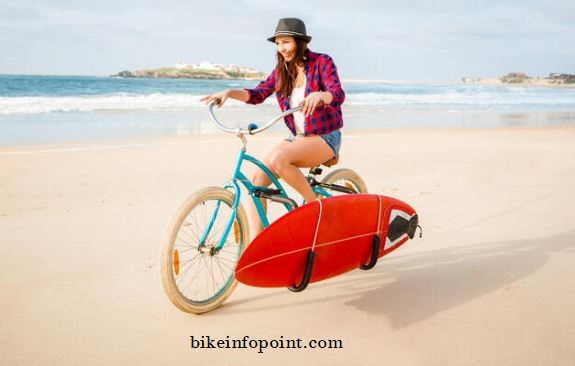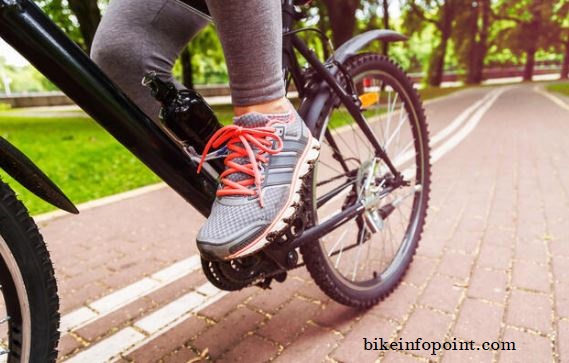
How to Carry a Surfboard on a Bike
Importance of being able to carry a surfboard on a bike: Carrying a surfboard on a bike can be a convenient and eco-friendly way to transport your surfboard to the beach. Instead of driving a car and contributing to traffic and pollution, you can pedal your way to the surf with your board in tow. This not only helps reduce your carbon footprint, but it can also be a fun and active way to start your surf day. Additionally, being able to carry your surfboard on a bike can save you money on gas, parking fees and surfboard rental costs.
In some areas, having a bike and being able to carry your surfboard on it can also offer greater flexibility and access to more remote surf spots that may not be easily accessible by car. This can be especially advantageous for surfers who are looking for less crowded and more secluded surf spots.
Table of Contents
ToggleMaterials Needed
A. Bike with a sturdy frame and functioning brakes: A sturdy and well-maintained bike is an essential component of carrying a surfboard on your bike. The bike’s frame should be strong enough to support the weight of the surfboard, which can be quite heavy, especially if it is a larger board. A strong frame also helps to ensure the safety of the rider and the surfboard while in transit.
Additionally, the bike should have functioning brakes to ensure that you can safely stop the bike and control your speed while riding with the surfboard. Brakes are especially important when riding with a heavy load. Because it can be more difficult to control your speed and stop quickly.
B. Straps or bungee cords: Straps or bungee cords are crucial for securing the surfboard to the bike. It keeps the surfboard in place and prevents it from falling off or shifting while riding. There are a variety of straps and bungee cords available, so it is important to choose ones that are strong enough to hold the weight of your surfboard and that are easy to use.
When selecting straps or bungee cords, consider factors such as the length, width, and thickness of the straps, as well as the type of hook or attachment used. Some straps come with built-in hooks, while others require the use of separate hooks or clasps. The right straps or bungee cords will ensure that your surfboard stays securely attached to your bike during transit.

Preparing the Surfboard
A. Remove any sharp objects or fins: Before attaching the surfboard to your bike, it is important to remove any sharp objects or fins that could potentially damage the bike or cause injury to the rider. This includes removing the center fin and any other sharp or protruding fins, as well as removing any other sharp objects such as sand or rocks that may be lodged in the fins.
B. Wrap the surfboard in a soft cloth or padding to prevent scratches or damage: Wrapping the surfboard in a soft cloth or padding can help prevent scratches or damage to the surfboard while it is being transported on the bike. This is especially important if the surfboard will be in direct contact with the bike or if the bike will be jostled during transit.
Cushioning the surfboard with a soft cloth or padding can help to absorb any bumps or shocks during transit and can also protect the surfboard from scratches or abrasions that may occur from contact with the bike. Some surfers use foam padding, beach towels, or other soft materials to protect their surfboards, while others use specialized surfboard bags or sleeves. The key is to use something soft and protective to help keep the surfboard in good condition.
Attaching the Surfboard to the Bike
A. Installing a rack or basket attachment: Installing a rack or basket attachment is an essential step in attaching the surfboard to the bike. A rack or basket provides a stable platform for the surfboard and helps to distribute the weight evenly on the bike. There are several different types of racks and baskets available, including rear racks, front baskets, and pannier racks.
When selecting a rack or basket, consider factors such as the size and weight of the surfboard, the type of bike you have, and the conditions you will be riding in. Some racks are designed to hold larger surfboards, while others are better suited for smaller boards. It is important to choose a rack or basket that is compatible with your bike and that can securely hold the weight of your surfboard.
B. Securing the surfboard with straps or bungee cords: After installing a rack or basket, the next step is to secure the surfboard to the bike using straps or bungee cords. This involves placing the surfboard in the rack or basket and then securing it in place with the straps or bungee cords.
It is important to secure the surfboard tightly to prevent it from shifting or falling off during transit. When using straps, it is best to cross the straps over the surfboard and attach them to the opposite side of the bike, creating a tight X-shape. When using bungee cords, stretch the cords tightly over the surfboard and secure them to the rack or basket using hooks or clasps.
C. Placing the surfboard in the rack or basket and securing it securely: Once the surfboard is securely wrapped and the straps or bungee cords are attached, the next step is to place the surfboard in the rack or basket and secure it in place. This involves lifting the surfboard and carefully placing it in the rack or basket, ensuring that it is centered and securely fastened.
It is important to check that the surfboard is secure and that the straps or bungee cords are tight before beginning to ride. It is also a good idea to periodically check the surfboard while riding to ensure that it is still securely attached to the bike.
Read More Article
How to Carry a Beach Chair on Your Bike
How to Carry Phone While Cycling
Riding with the Surfboard

A. Maintaining a slow and steady pace: When riding with a surfboard attached to your bike, it is important to maintain a slow and steady pace. This helps to ensure that you have enough control over the bike and that you can safely navigate any obstacles or turns.
Riding too fast can be dangerous, as it can make it difficult to control the bike and can increase the risk of accidents or falls. It is also important to avoid sudden stops or turns, as these can cause the surfboard to shift or fall off the bike.
B. Balancing the weight of the surfboard on the bike: Balancing the weight of the surfboard on the bike is an important factor in ensuring a safe and stable ride. The surfboard should be positioned so that the weight is distributed evenly on the bike and does not put too much pressure on any one side. If the surfboard is not balanced properly, it can make the bike unstable and increase the risk of accidents or falls.
C. Taking turns slowly and carefully: When taking turns while riding with a surfboard attached to your bike, it is important to take turns slowly and carefully. This helps to prevent the surfboard from shifting or falling off the bike, as well as to maintain control of the bike.
D. Avoiding rough or uneven terrain: Avoiding rough or uneven terrain is important when riding with a surfboard attached to your bike. Rough terrain can cause the surfboard to shift or fall off the bike, or it can damage the surfboard or the bike.
E. Storing the surfboard properly when not in use: When you reach your destination and the surfboard is not in use, it is important to store it properly. This involves removing the straps or bungee cords, removing the surfboard from the rack or basket, and storing it in a safe and secure place.
Storing the surfboard properly helps to protect it from damage and to ensure that it is in good condition for your next surf session. Avoid leaving the surfboard in direct sunlight, as this can cause it to warp or fade, or avoid leaving it in damp or humid conditions, as this can cause it to develop mold or mildew.

